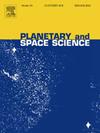对冰的起源有了新的认识:水星上14个永久阴影陨石坑的年代含义
IF 1.7
4区 物理与天体物理
Q3 ASTRONOMY & ASTROPHYSICS
引用次数: 0
摘要
水星极地地区的特点是被称为永久阴影区(PSRs)的区域,在地质时间尺度上为水冰提供了稳定的热条件。地面雷达测量和美国宇航局/信使号航天器的数据都确定了psr周围的区域,其反射特性表明存在水冰和其他挥发物。在这项工作中,我们对14个产生冷阱和冰的北极陨石坑的喷出物和陨石坑底物质采用陨石坑计数绝对模型年龄测定。我们的发现揭示了地表比相关喷出物更年轻的年龄,促使我们进一步研究冰作为极地陨石坑地表恢复活力的机制所起的作用。值得注意的是,陨石坑的年龄与psr内冰的积累之间存在相关性。事实上,按面积计算,较老的陨石坑倾向于在psr内积累更多的冰。这些相关性可能归因于两个主要过程,即微陨石通量和太阳风注入,使冰持续积累。考虑到这些过程的限制因素,分别是撞击速度和园艺,估计在大约37亿年(本研究中最古老的陨石坑的年龄),大量的冰将在两极积聚。分析的两个陨石坑没有遵循这一趋势,这可能意味着小行星和/或彗星撞击造成的间歇性冰输送。因此,我们建议在分析psr中冰的存在时,应考虑稳态积累和偶发输送过程。本文章由计算机程序翻译,如有差异,请以英文原文为准。
New insights into the origin of ice: chronological implication from 14 permanently shadowed craters on Mercury
The polar regions of Mercury are characterised by areas known as permanently shadowed regions (PSRs), which provide stable thermal conditions for water ice over geological timescales. Both Earth-based radar measurements and data from the NASA/MESSENGER spacecraft identified the area encompassing the PSRs with reflectance properties indicative of both water ice and other volatiles.
In this work, we employ crater counting absolute model age determination on both ejecta and crater floor materials of fourteen northern polar craters yielding cold traps and ice. Our findings unravel younger ages for the floors than for the associated ejecta, prompting further investigation into the role of ice as the mechanisms responsible for rejuvenating polar crater floors. Notably, a correlation emerges between the age of craters and the accumulation of ice within PSRs. Indeed, older craters tend to accumulate more ice within the PSRs, measured in terms of area. These correlations may be attributed to the two primary processes allowing ice continuous accumulation: micrometeorite flux and solar wind implantation. Considering the limiting factors for these processes, which are impact velocity and gardening, respectively, it is estimated that over approximately 3.7 billion years (the age of the oldest craters in this study), a substantial amount of ice would have accumulated at the poles. Two of the analyzed craters do not follow the trend and this might signify episodic delivery of ice resulting from asteroidal and/or cometary impacts. Thus, we propose that both steady-state accumulation and episodic delivery processes should be considered when analyzing the presence of ice in PSRs.
求助全文
通过发布文献求助,成功后即可免费获取论文全文。
去求助
来源期刊

Planetary and Space Science
地学天文-天文与天体物理
CiteScore
5.40
自引率
4.20%
发文量
126
审稿时长
15 weeks
期刊介绍:
Planetary and Space Science publishes original articles as well as short communications (letters). Ground-based and space-borne instrumentation and laboratory simulation of solar system processes are included. The following fields of planetary and solar system research are covered:
• Celestial mechanics, including dynamical evolution of the solar system, gravitational captures and resonances, relativistic effects, tracking and dynamics
• Cosmochemistry and origin, including all aspects of the formation and initial physical and chemical evolution of the solar system
• Terrestrial planets and satellites, including the physics of the interiors, geology and morphology of the surfaces, tectonics, mineralogy and dating
• Outer planets and satellites, including formation and evolution, remote sensing at all wavelengths and in situ measurements
• Planetary atmospheres, including formation and evolution, circulation and meteorology, boundary layers, remote sensing and laboratory simulation
• Planetary magnetospheres and ionospheres, including origin of magnetic fields, magnetospheric plasma and radiation belts, and their interaction with the sun, the solar wind and satellites
• Small bodies, dust and rings, including asteroids, comets and zodiacal light and their interaction with the solar radiation and the solar wind
• Exobiology, including origin of life, detection of planetary ecosystems and pre-biological phenomena in the solar system and laboratory simulations
• Extrasolar systems, including the detection and/or the detectability of exoplanets and planetary systems, their formation and evolution, the physical and chemical properties of the exoplanets
• History of planetary and space research
 求助内容:
求助内容: 应助结果提醒方式:
应助结果提醒方式:


